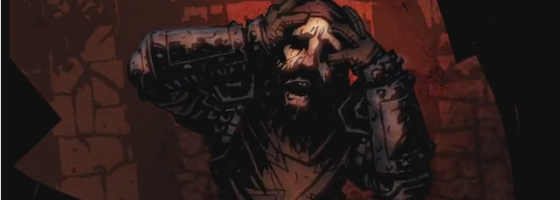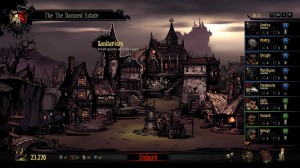Darkest Dungeon has been on my must play list since the first day I saw the Kickstarter promo for it. After months of early access playtesting and new content, the game is finally ready for 1.0. Darkest Dungeon is a brutal game that hits all the rogue-like and Lovecraft notes almost perfectly.
Welcome Home:
The story of Darkest Dungeon is that you are returning to the hamlet that your family owned after a very long time. The previous caretaker became obsessed with unearthing a powerful evil that has now spread throughout the estate and threatens to kill us all. Your mission is to hire groups of adventurers to go into the estate and start to take things back from the evil; with the ultimate goal of stopping the eldritch menace that has taken root.
Let’s get the obvious excellent part out of the way: The game looks and sounds amazing. The art style pops with a stylized gothic feel that really showcases the environment and creature designs. The narrator’s gravelly voice ties it all together to deliver an impressive and oppressive feel.
There are two main game systems of the Darkest Dungeon. The first one is the hamlet itself, which acts as a meta-game component that ties everything together. On your excursions to the estate, you’ll pick up heirlooms that can be used to upgrade the buildings back in town. This is critical, because they will allow you to better outfit your heroes and get them to recover faster (more on that in a minute.)
Each area of the estate is completely unique, and features different enemies, challenges and traps to deal with. As the game goes on, more areas will open up; including the final area, appropriately titled: the Darkest Dungeon.
With that said, the real treat of the game is the combat system, and the madness that goes with it.
Going Crazy:
Darkest Dungeon’s tactical system was another highly touted mechanic back from the kickstarter. On a quest into the game’s procedurally generated dungeons, you’ll take a party of four adventurers out. The classes in the game are varied; providing you with unique skills and personalities. The hook is that these are not powerful heroes, but people who are somewhat broken.
Besides worrying about taking damage and dying, you also have to keep an eye on their sanity. As time goes on, characters will take sanity damage from spending time in the dungeons and from taking certain attacks. If they gain too much damage, they’ll crack and will either suffer a penalty until they recover, or rise to the occasion with a buff.
The other part of the psychological trauma has to do with the personalities of your party members. Overtime, they will get quirks, both good and bad that will affect them. These quirks can do everything from increasing damage, to making characters more likely to investigate potential traps. You can recover stress and remove negative quirks from the hamlet; with the ability to improve buildings to enhance their potency.
Combat is turn-based with your group of four up against another group. Characters have one action per turn (with exception to bosses,) and the order is different each round. Fighting the enemies in the game will require you to learn their attacks and know the best ways to deal with them. Heavy enemies can do massive damage, but can be disabled with the right debuffs and stuns.
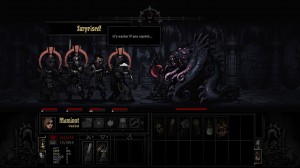
Combat requires you to juggle the positioning and skills of your characters in order to come out on top.
Protection provides a resistance to all damage, but leaves the enemy open to poison and bleed attacks. The as-mentioned sanity system comes into play here, with enemies capable of inflicting sanity damage just as intense as physical damage.
The different classes provide a variety of party compositions and potential strategies for you to discover. Part of the challenge of the combat is the fact that every character has different reaches with their attacks; affecting where you play them in your composition and what this means against the enemy’s party.
The lighting in the dungeon acts as a risk/reward mechanic that the player can control. As you explore, the light from your torch will go out; the darker it gets, the more damaging everyone’s attack is and the greater the rewards. However, as things get dark, enemies hit harder and you’ll take greater stress damage.
The beauty of the Darkest Dungeon is how everything ties together between the various systems and mechanics. You’ll need to balance how far you push into the dungeons to make sure your favorite adventurers aren’t dying as the game features iron man rules. At the same time, you want to get resources to upgrade the hamlet and find powerful trinkets to help give your party an edge.
Once your party does hit level 6, you can go into the final dungeon at anytime, but you need upgraded gear and trinkets in order to stand a chance. All these different systems work great together and help the Darkest Dungeon stand out.
With that said, the path to the Darkest Dungeon is a gloomy one, and does present some hurdles to overcome.
Shaken Up:
The Darkest Dungeon has had some challenges in the past with its difficulty curve and trying to find the right balance between being difficult and being cheap. The early play of the game can be very hard as you’re trying to learn all the elements of the game and having your failures punished by lost of resources and party members. Similar to XCOM, you cannot get attached to your early party members, as it’s very easy for them to get killed or inflicted with so many quirks and diseases that it’s not worth it to fix them up.
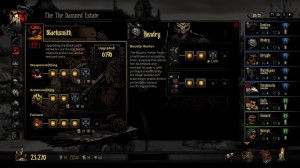
The game forces you to grind quests in order to get the heirlooms needed to improve your gear and the gold to actually buy it.
To be fair, balance changes have made the early game a lot easier to play; due to changes in class skills and enemy stats at that level. As you move up in difficulty, the enemies become a lot nastier; forcing you to make use of upgraded equipment.
The problem is that this presents a bit of a grind to the game; requiring you to go on repeated dungeon runs in order to get the resources to stand a chance.
Player knowledge will only get you so far, and without having the extra damage and health from upgrading weapons and armor respectively, you won’t survive long on the higher quests.
The game features bosses to fight, but other than a check on your goals page, they don’t offer anything game changing for fighting them. It would have been interesting to give special rewards for fighting the bosses, either unique trinkets or upgrades to the hamlet; anything to make them attractive to fight and provide some kind of a mid game progression alternative to just getting to the Darkest Dungeon.
Speaking of the final dungeon, it can also be considered another grind. The reason is that win or lose, you’re going to lose party members from it. What that means is in order to beat the game, you’ll need a lot of level 6 characters to sacrifice themselves; leading to more grinding out dungeons to do so.
Another point has to do with the classes. Playing through the game and looking at everyone, I wish that there were more synergies and uses for skills. The issue is that skills that just buff one person are just woefully weaker than skills that attack, affect the group or have multiple roles like heal and cause damage.
The reason is that you only have four actions per turn and spending one action to buff someone who then misses means that you wasted half your available actions. Also, every turn you are healing/buffing and not attacking, means that the enemies get another turn to attack and possibly do severe harm to you.
It’s very easy for things to go terribly wrong during a run: a string of misses, critical hits from the enemies, etc. If you’re not careful (or lucky,) you can run into a negative feedback loop of losses that take away your resources. While the normal game doesn’t have a game-over, it can feel like it if you run out of money and are unable to outfit anyone.
Because character levels mean everything, it also presents another form of grinding, as you won’t see everything without getting level 6 heroes and keeping them alive. Losing a high level party means hours of time spent gone (along with the gold to upgrade them,) and it’s back to square one to level more up.
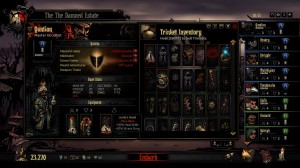
The trinket system is fiddly, cumbersome, yet required at the mid to late game to give your characters a chance at winning
It feels like Darkest Dungeon is just missing one more system of progression between the early game hamlet upgrading and preparing for the final dungeon to completely tie the beginning, mid and end games together.
Examining things further, the developers raised the number of resources needed for the mid to high level upgrading, but there isn’t anything in the mid-game that is different from the early game; again, giving that feeling that something is missing.
One suggestion would be to add in exclusive trinkets that only show up on veteran and up; providing the player with something to go after.
Speaking of trinkets, their use and UI are in my opinion the current low point of the game. The reason is that it’s very cumbersome to have to constantly un-equip and re-equip different party members. Trinkets either range from not being strong enough or have too many debuffs to be worth it, to being so strong that they will define your characters at the mid and end game.
Light at the end of the tunnel:
Despite my complaints, Darkest Dungeon is a great game, an amazing first title from Redhook Games and I hope the foundation for more games and growth in the future. The game’s underlining mechanics and aesthetics are strong enough to keep you invested in the title, even though there is grinding once you hit the mid-game. Redhook has already announced that they are planning three expansions for it over 2016; the first one adding in town events and the merchant class as per the stretch goals.
It’s rare to see a game of this quality as the first title out of the gates for a studio, and hopefully this can only mean more good things from Redhook in the future. To watch my livestream attempt at beating the game from start to finish, you can check out the playlist here.

